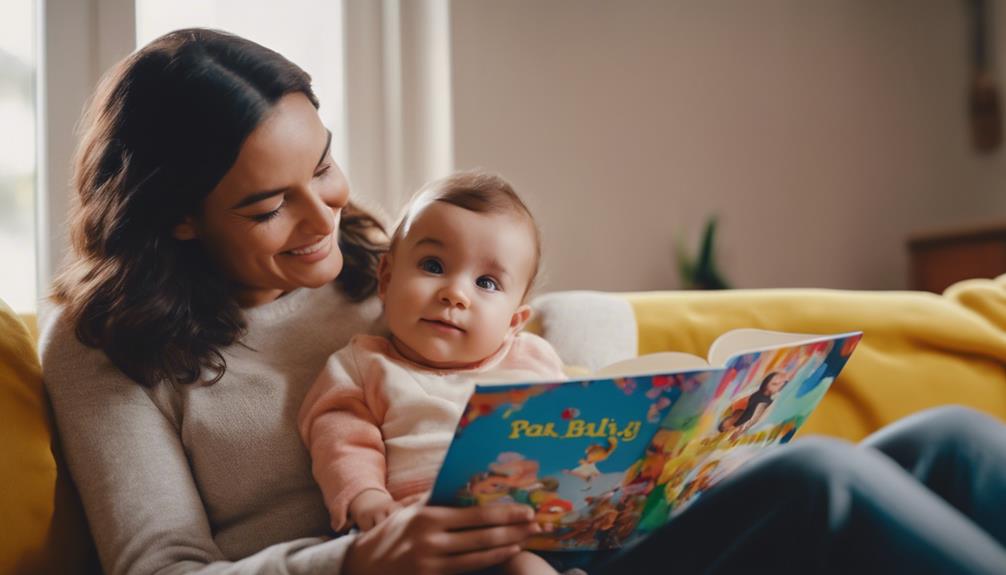To create a calming routine, set a consistent time each day for your baby’s storytime and choose a cozy, quiet spot with soft lighting. Use gentle voices and simple, soothing stories or sensory books to keep your baby relaxed. A familiar environment and patience help your little one associate this time with comfort and sleep. Keep going, and you’ll discover even more tips to make this ritual truly special.
Key Takeaways
- Establish a consistent daily schedule for storytime to signal relaxation and bedtime.
- Create a cozy, quiet environment with soft lighting and a designated comfortable spot.
- Choose gentle, soothing stories and use a calm tone to promote relaxation.
- Incorporate sensory books with textures to engage senses and enhance calming effects.
- Practice patience and maintain a gentle routine to help babies associate storytime with comfort and sleep.

Have you ever wondered why some families have special routines around reading? It’s because establishing a consistent storytime creates a calming environment that helps your baby feel safe and loved. When you set aside a specific time each day for reading, you’re not just sharing stories—you’re building a comforting ritual that signals it’s time to wind down. This consistency helps your baby associate these moments with relaxation, making bedtime smoother and more predictable. You can start by choosing a cozy spot in your home where your little one feels comfortable and secure. Keep the lighting soft and the atmosphere quiet to foster a peaceful mood.
Creating a consistent storytime helps your baby feel safe, loved, and ready to relax at bedtime.
Incorporating bedtime stories into your routine works wonders for bonding and language development. Opt for gentle, soothing stories that relax your baby rather than excite them. Over time, this creates a positive association with reading, turning it into something they look forward to every evening. As your baby begins to recognize the routine, it becomes a cue that sleep is approaching, helping to ease separation anxiety and establish healthy sleep habits. Remember, it’s not just about the story itself but the ritual of sharing that moment together. Make eye contact, use gentle voices, and cuddle close to reinforce your bond.
Sensory books are especially effective in these calming routines because they engage your baby’s senses and keep them interested without overstimulating. These books often feature textures, crinkles, or other tactile elements that invite your little one to explore with their hands. As they touch and feel, they develop fine motor skills and sensory awareness, all while enjoying the soothing experience of reading. Incorporating sensory books into your bedtime ritual adds an interactive element that helps your baby stay present and calm during storytime. You can choose books with soft fabrics, crinkly pages, or textured surfaces to stimulate their senses and keep them engaged.
The key is consistency and patience. Your baby might not immediately settle into the routine, but with time, they’ll start to recognize the cues and begin to relax as soon as you pick up the book. Keep your tone gentle, the stories simple, and the environment cozy. Over days and weeks, this routine becomes a cherished part of your daily life, helping your baby feel safe and secure at bedtime. Establishing a consistent routine with a calming environment and appropriate sensory elements creates a soothing atmosphere that promotes healthy sleep habits and strengthens your emotional connection. Ultimately, creating these calming storytime rituals fosters a loving connection and sets the stage for healthy sleep habits that last a lifetime.
Frequently Asked Questions
When Is the Best Time of Day for Baby Storytime?
You should choose a time that fits your baby’s natural rhythm, often during morning cuddles or bedtime stories. Morning is great when your baby is alert and attentive, making storytime enjoyable. Alternatively, bedtime stories help your little one wind down and feel secure. Consistency is key, so pick a time that works best for your routine, ensuring these moments become a calming, cherished part of your daily life together.
How Do I Choose Age-Appropriate Books for My Baby?
When choosing age-appropriate books for your baby, look for ones with simple language and vibrant visual cues that capture their attention. Books with high-contrast images or familiar objects promote engagement and support vocabulary development. You’ll want to select sturdy board books for little hands and avoid complex stories. As your baby grows, gradually introduce more detailed books to foster their understanding and love of reading.
Should I Include Music or Singing During Storytime?
Think of music as the heartbeat of your storytime, bringing rhythm to the routine. Including music integration and singing benefits your baby’s language development and emotional comfort. You should definitely include singing or music, making the experience more engaging and soothing. It’s like a gentle lullaby that signals bedtime is near, helping your little one feel safe and connected, creating a calming atmosphere for both of you.
How Can I Make Storytime Engaging for a Restless Baby?
When making storytime engaging for a restless baby, you should focus on interactive storytelling and sensory activities. Use expressive voices, facial expressions, and gestures to hold their attention. Incorporate sensory activities like textured books, soft fabrics, or gentle touch to stimulate their senses. Keep the sessions short and lively, allowing your baby to participate actively. This approach keeps them engaged, makes reading fun, and helps build a love for books early on.
What Are Signs My Baby Is Ready to Transition to Longer Stories?
You’ll notice your baby’s ready to shift when their visual cues show increased interest, like sustained eye contact or focused gazes. If their attention span lengthens, they can sit through longer stories without fussing. You might also see curiosity sparks, with your baby keen to explore the pictures and listen longer. These signs indicate they’re developmentally prepared, making it a great time to introduce more extended stories into your routine.
Conclusion
By establishing a cozy storytime ritual, you create a calming environment that fosters your baby’s love for reading. Consistency helps your little one feel secure and enthusiastic to explore stories. Did you know that infants who experience daily reading routines show improved language skills by age two? Keep your ritual simple and relaxed—soon, those quiet moments will become cherished memories, laying a strong foundation for your child’s lifelong love of books and learning.










